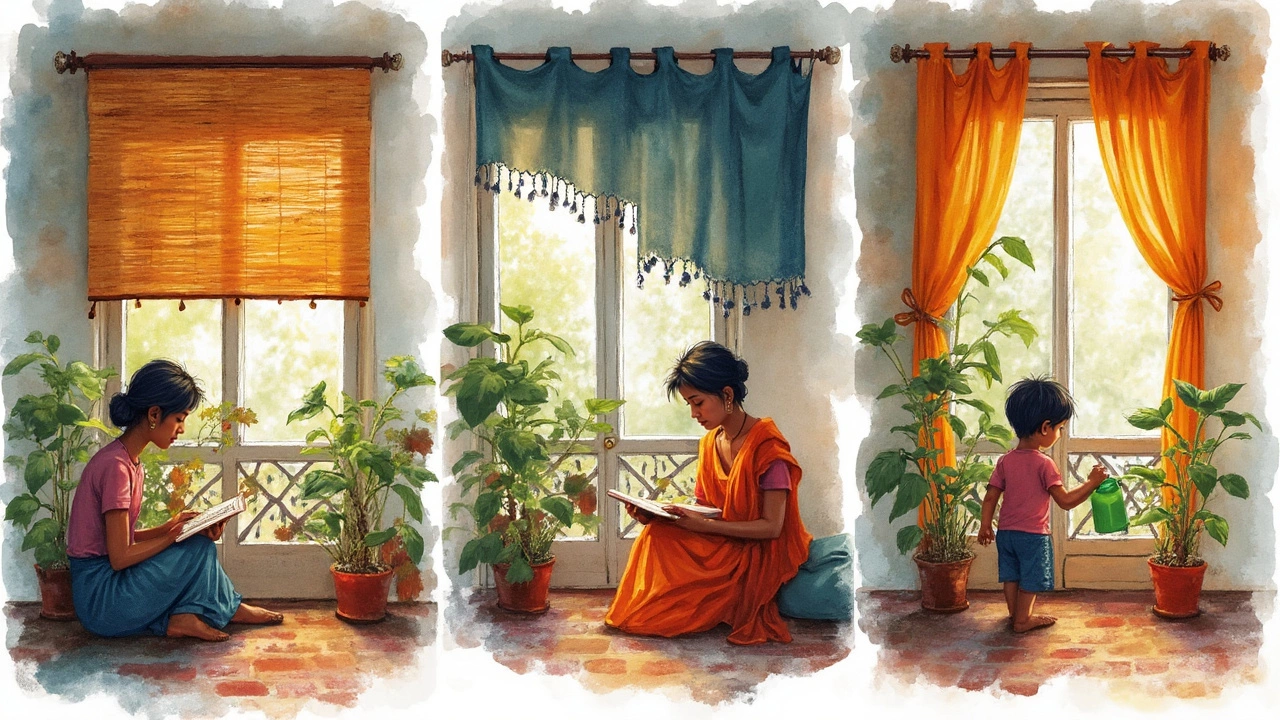Balcony life’s amazing till you get cooked by the midday sun. If you’ve ever tried watering plants out there or just relaxing with a drink, you know how quickly the heat can ruin the mood—plus, direct sun fries your favorite plants and fades your furniture fast. The good news? Even if you’ve got a tiny rental or low-budget setup, you can make real, effective shade without needing to call a contractor.
Shade is about more than comfort. It keeps your balcony cooler, protects your skin, stops your basil from wilting, and saves money by letting you skip the air conditioner. Not every fix needs to be fancy. Sometimes, a simple solution like a well-placed umbrella or some clever fabric is all it takes to totally change your balcony vibe.
Ready to block the sun and get your evenings back? The next sections walk you through the best ways to make shade — from dead-easy pop-up gear to creative DIY tricks. No need for a toolbox or deep pockets. Let's make your balcony the coolest spot in the building.
- Why Shade Matters for Balconies
- Simple Shade Solutions for Any Balcony
- Clever DIY and Budget Hacks
- Tips for Picking the Best Shade for Your Space
Why Shade Matters for Balconies
If you spend even a few minutes on an uncovered balcony at noon, you know just how much you need shade. Summer sunlight can push balcony surfaces over 120°F (49°C). That’s uncomfortable for you and deadly for most garden plants. Direct sun can toast herbs like mint or basil in less than a week, fade your outdoor cushions, and even cause plastic furniture to crack faster.
There’s more going on than just the obvious heat. Too much UV rays is rough on your skin—you could get burnt in less than 20 minutes when the sun’s strong. And it messes up your indoor temperature too, since sunlight streaming through the windows goes straight into your living space and turns your apartment into a sauna. Covering your balcony shade area can actually bring your energy bills down, especially if you like to keep your doors open for the breeze.
How much sun is too much? Check out these numbers below:
| Condition | Without Shade | With Shade |
|---|---|---|
| Balcony Surface Temp (2pm, July) | 120°F (49°C) | 85°F (29°C) |
| Sunburn Time (Fair Skin) | 15-20 mins | 50+ mins |
| Plant Survival (Basil, 1 week) | 58% alive | 91% alive |
Plus, shaded balconies keep your outdoor gear and cushions from fading nearly as fast. If you just bought patio chairs, throwing a fabric or a shade sail over them could let them last years longer. No one wants to buy new furniture every summer.
So, adding some shade isn’t just about staying cool. It’s about making your plants, your wallet, and your skin happier. Ready to see what actually works? The next section’s where the real hacks start.
Simple Shade Solutions for Any Balcony
Finding a smart way to get shade on your balcony doesn’t have to take all weekend or eat up your savings. There are a bunch of ready-made options you can set up in an hour or less, and most of them work even if you’re renting.
The absolute easiest fix is a patio umbrella. No holes, no fuss – just grab a stand and plop it wherever you need the most cover. Pick one with a tilt function so you can block the sun as it moves across the sky. For small balconies, try a compact half umbrella that sits flat against your wall or railing.
Another top pick is the outdoor shade sail. These are those triangle or square pieces of weatherproof fabric that you stretch from your railing to a hook or post. They look sharp, they’re light, and installation is as simple as hanging a hammock. Just double-check your landlord’s rules before screwing anything into the building.
Retractable awnings are the pricier option, but you get major payoff in how comfy they make your balcony. You can roll them out on the hottest afternoons and tuck them back when you want sunshine. Some awnings clamp onto railings or walls without drilling, which is a huge win if you want to keep the landlord happy.
Don’t forget about balcony screens or outdoor curtains. These are literally just weather-resistant fabric panels you hang from a tension rod or hooks. Slide them open or closed depending on the angle of the sun. They block glare, add privacy, and you can swap them for new colors anytime you want a fresh look.
- Patio umbrella: Fast and flexible shade for any size balcony.
- Shade sail: Affordable and cool-looking, just make sure you can anchor it safely.
- Retractable awning: More of an investment, but super practical if you use your balcony a lot.
- Outdoor curtains: Ultra-flexible, look good, and double as privacy screens.
If you want to really stretch your space, use more than one solution—like a small umbrella for everyday use and a set of curtains for serious heat waves. That way you’re always prepared and your spot’s looking sharp. Looking for that pro tip? Go for light-colored fabrics, which reflect sunlight and keep your balcony cooler than anything dark. And remember, blocking the sun isn’t just about comfort—it’s key for protecting your balcony shade setup from fading and damage.

Clever DIY and Budget Hacks
If you want decent shade without breaking the bank, there’s a bunch of smart tricks that work even on tiny balconies. The best part? You don’t need fancy tools or a ton of money. Balcony shade comes down to using simple materials, knowing a few tricks, and getting a bit creative.
Let’s start with fabric. An outdoor curtain rod (or even a tension rod wedged between the walls) plus a plain old shower curtain can make instant shade that you can open or close as you need. Just make sure you get fabric that can handle rain and sun. Polyester and canvas shower curtains hold up better than cotton, and they’re easy to wipe clean. If your balcony railing lets you, use zip ties or strong clamps to hold the curtain in place.
Another easy fix: shade sails. These have exploded in popularity because they’re cheap, lightweight, and work for weird-shaped spaces. You can buy a pre-made one for under $30, but here’s a hack—make your own from thick canvas or mesh. All you need are grommets (the holes for string), some rope, and a place to anchor each corner. Tie two ends to your balcony railing and the others to hooks or even heavy pots. A tight, sloping angle stops water from pooling up when it rains.
Umbrellas get overlooked but work super well, especially if you want to move shade around. Most people don’t realize you don’t need an umbrella stand if you’ve got a heavy planter. Just jam the umbrella pole deep in the soil and, boom, instant portable shade. Tilting umbrellas are best because you can angle them as the sun moves.
If you’re handy with a staple gun, try stapling light-colored canvas or burlap right to a cheap wood frame. Lean or hang these panels up against the balcony railing for a quick sunblock. It doubles as a privacy screen, too—the old ‘two birds’ trick. For renters, use hook-and-loop tape or large binder clips instead of stapling so you don’t leave marks.
Finally, some people use recycled stuff—think bamboo fencing, old bedsheets, or even a roll-up beach mat for shade. Just attach with string, rope, or zip ties wherever you need a little block from the sun.
- Always check that your shade fix is sturdy, especially on windy days. Nothing’s worse than chasing fabric down the street.
- Go for lighter colors—they reflect more sunlight and keep things cooler underneath.
- Keep things flexible so you can take everything down fast in bad weather.
With just a few bucks and an hour or two, you can totally transform how your balcony feels during those sunny afternoons.
Tips for Picking the Best Shade for Your Space
It’s easy to get lost in all the gear and gizmos, but picking the right balcony shade comes down to a few real-life things: size of your space, where the sun hits, how much you want to spend, and if your landlord’s rules are strict. If you pay attention to those, you’ll never end up with a floppy umbrella catching the wind or a saggy sun sail that looks sad after two weeks.
Balcony shade solutions come in all shapes and sizes, so don’t just grab the first thing online. Here’s what really matters:
- Direction of sunlight: If your balcony faces south or west, you’re going to get hammered by the sun most of the day. In that case, go for bigger coverage like retractable awnings, shade sails, or tall outdoor fabric curtains. For east or north-facing spots, you might get by with smaller fixes like a parasol or bamboo screens since the sun’s coverage is softer.
- Wind exposure: High balconies catch a lot of wind. Cheap umbrellas and flimsy fabric panels will shred fast. Stick with sturdy hardware and fabric rated for outdoor use. If you live somewhere gusty, choose options that can be secured tightly like heavy-duty clamps or weighted bases.
- Size and layout: Measure your balcony! You don’t want to buy a shade sail that's too big to hang. For tiny spaces, try vertical solutions (think roller blinds or tall plants) instead of wide covers.
- Local rules: If you’re renting, check what you can actually install. Some buildings won’t let you drill or bolt anything. Temporary shades using zip ties, pressure poles, or heavy pots work wonders here.
- Material and upkeep: Sun and rain beat stuff up quick. Go for UV-stabilized fabric or rust-resistant metal. Cheap cloth fades and weakens in one season.
Check this quick table for how common shade options stack up (the numbers are realistic averages for 2024):
| Shade Type | Average Price (USD) | Best Use | DIY Friendly | Durability (Years) |
|---|---|---|---|---|
| Umbrella | $35–$120 | Small balconies, renters | Yes | 2–3 |
| Shade Sail | $40–$150 | Medium-large, owner | Yes | 3–5 |
| Outdoor Curtains | $30–$100 | Privacy + shade, any size | Yes | 2–4 |
| Retractable Awning | $150–$600 | Permanent, large space | No | 5–10 |
| Bamboo Screens | $25–$80 | East/north sides, rustic look | Yes | 2–4 |
A little extra tip: sometimes all you need is a tall plant (like a potted banana tree) placed in the right spot. Not only do they look good, but they also throw shade and cool the area.
At the end of the day, don’t just chase trends. Pick something that fits your sun, your space, and your budget—and you’ll actually use it all summer.

